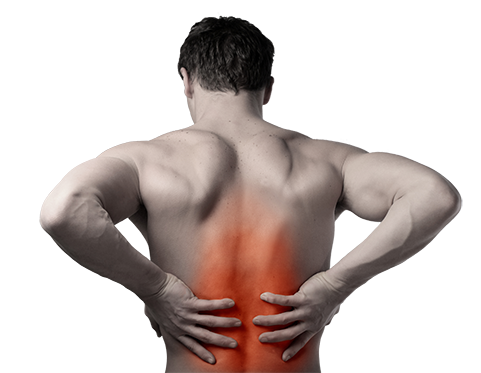What We Treat
This is a list of common conditions treated by Physiotherapists but is not exhaustive and there are many other conditions we can help with. Please contact us for further details.

Back Pain
Back pain is probably the most common musculoskeletal problem with 31 million working days lost last year in the UK. It often affects the lumbar (lower) and thoracic (mid) spine and may come on with for no obvious reason with frequent recurrence.
The source of pain can be related to the discs, the joints between the vertebrae, ligament sprains and is often brought about by repeated poor postures which overload these structures.
The sacro iliac joints are located at the junction between lumbar spine and pelvis and are commonly related to back pain in pregnancy and post delivery. Scoliosis may be structural or related to leg length discrepancy and may cause pain in the lumbar and thoracic areas. Spinal stenosis causes back pain which radiates down the legs particularly with prolonged standing.
Sciatica
Irritation or compression of the sciatic nerve causes pain from the back and radiates throughout the leg. It may be associated with altered sensation in the foot (paraesthesia) and can be very severe and disabling. The majority of true sciatica is caused by a herniated disc often referred to as “slipped disc”.
Neck Pain

This is common particularly in office workers who spend large amounts of time sitting in front of a screen. The pain may radiate from the neck down the arm and may cause pins and needles in the hand. It can be attributable to poor posture and may cause headaches – cervicogenic. It may also be related to arthritis or spondylosis.
Whiplash
Whiplash is neck pain caused by sudden movements of the head forwards, backwards or sideways. Road traffic collisions are the most common cause of whiplash but a slip or fall or impact where the head is forced backward relative to the neck may also cause whiplash.
Hip & Groin Pain

Hip and Groin pain can be related to the hip joint itself or to the pelvic joints between the back and pelvis. Osteoarthritis commonly affects the hip; 66000 hip replacements were performed in the UK in 2013.
Groin strains, tears in the lining of the joint (labrum) and impingement give rise to pain in the hip, groin or buttock.
Less common causes of pain in the hip can be related to osteitis pubis, stress fracture, trochanteric or gluteal bursitis.
Knee Pain
The knee complex is made up of the tibiofemoral (hinge) joint and the patella femoral (kneecap) joint. Knee pain may be caused by injury or overuse. The cruciate, medial and lateral ligaments can be injured during sports or trauma. The cartilages (meniscus) are the shock absorbers within the knee and are frequently torn with excess force or degenerate with the aging process. Osteo arthritis can be related to aging or previous injury and can affect the tibiofemoral and/or patellofemoral joints. Patellar tendinitis and prepatellar bursitis ( housemaids knee) gives rise to pain in the front of the knee. Osgood Schlatters disease in children also leads to pain in this area. Altered foot posture or poor core stability leads to faulty biomechanics in the lower limb and can contribute to knee pain.
Foot & Ankle

Ligament sprains, calf tears and peroneal tendinitis are common causes of ankle pain.
Plantar fasciitis, metatarsalgia and Mortons Neoroma give rise to pain felt in the sole of the foot.
Achilles tendinitis or Achilles tendon tear lead to heel pain. Severs disease leads to heel pain in adolescents during the growth phase.
Often foot and ankle pain is associated with faulty biomechanics as the foot strikes the ground abnormally.
Sprains, Strains, Muscles & Ligaments
Soft tissue injuries can cause sprains, strains, contusions or haemotoma. All benefit from early physiotherapy intervention.
Headaches
Tightness in the soft tissues which connect the neck to the base of the skull frequently cause headaches which can be felt in the back of the head (occipital) the forehead ( frontal) and often radiate in to or around the eye socket. Stiffness and restriction of movement in the neck joints lead to headache. Repeated poor posture especially at work can be detrimental when sustained frequently or repeatedly and often leads to chronic headache.
Shoulder

Is a ball and socket joint which is stabilised by 3 tendons collectively called the rotator cuff. These tendons can be injured or compressed leading to rotator cuff impingement or tears.
Frozen shoulder (adhesive capsulitis) causes pain and increasing stiffness in the shoulder joint with no known cause. It often responds quickly to steroid injection followed by rehabilitation.
The labrum is a soft tissue structure which deepens the socket of the shoulder and can be torn when the shoulder dislocates; this often leads to recurrent dislocations.
Golfers Tennis Elbow
Both are common overuse injuries affecting either inside ( golfers) or outside (tennis) of the elbow. They often respond well to steroid injection followed by eccentric loading programme.
Elbow joint is less commonly affected by osteoarthritis but loose bodies can cause symptoms of locking.
Wrist Hand Injury
Arthritis, tendon injuries and overuse problems leading to tendonitis are the most commonly treated wrist and hand issues.
Trigger Finger Thumb
Trigger Finger Thumb is caused by a nodule which develops in the tendon which bends the affected digit. Respond well to steroid injection +/-splinting.
Balance & Mobility Problems
These can be related to the ageing process. Inner ear (vestibular) issues, neurological problems or loss of confidence following a fall trip or surgery. We are able to do home visits if the patient is housebound.
Tempero Mandibular (Jaw) Disorders
The jaw joint may give rise to pain which is commonly related to soft tissue problems or disorders associated with bite or alignment.
To book an appointment, or for further information on any of the conditions we treat, or the services on offer, please call the clinic on 01457 871777 or email physio@zen.co.uk.




